Ecommerce email marketing may not be the sexiest form of advertising but there’s no question it’s one of the most cost-effective ways to scale an ecommerce business. With an ROI of over 3600%, 56% of marketers say email is their top-performing channel for customer retention.
Building a successful ecommerce email marketing program takes time and effort, but once a program is established, it’s the most secure way to reach potential and existing customers.
72% of consumers said they prefer to hear from brands via email vs social media, and unlike a social following on Twitter or Facebook, you actually own and control your list of opted-in email addresses. Plus, since email is decentralized, there’s no risk of a single large corporation suddenly making it more expensive for you to reach your customers.
So are you ready to take your ecommerce email marketing to the next level? Put the 9 ecommerce email marketing best practices to use and prepare to watch your business grow like never before.
1 - Set Goals
Like most things in life, succeeding with ecommerce email marketing is all about execution, and to execute well you'll need a plan and a strategy. Regularly setting and reviewing goals is an ecommerce email marketing best practice for businesses of all sizes. You should have goals for your program, goals for each campaign and even goals for each email you send out.
With goals in place, decision-making becomes as simple as asking whether or not something will move you closer or further from that goal. Goals also improve efficiency and make it easier to see what's working, and what’s not.
To help define your goals, a few good questions to ask are:
- What is the desired outcome from our email marketing?
- What persona’s are we targeting?
- How will we measure and define if the program was successful?
Be specific in your answers and take the time to write answers down as you have these discussions. Email programs can have multiple goals, but maintaining a focus and understanding what the top priority is at any given time is vital for success in ecommerce email marketing.
For some businesses, boosting sales immediately will be the top priority, for others, keeping in touch with customers long-term and extending subscriber value is a better goal. Being clear about who you're emailing, why you are emailing them, and what you are hoping to accomplish is definitely one of the most important ecommerce email marketing best practices!
2 - Use Automation
Good ecommerce email marketing programs are built on marketing automation.
Automated workflows make it possible to segment on the fly as well as easily personalize offerings and delivery times, plus they save you a lot of time. Without marketing automation, it would be very difficult to scale an ecommerce website effectively, after all, you can’t write and send all those emails by hand once your business has thousands of customers!
Many of the eCommerce email marketing best practices you are about to learn require that you're using marketing automation. So pick a good platform with the features that you need, and take the time to master it.
3 - Maintain An Excellent Sender Reputation
Your email list is only valuable if you can actually reach the people on it. Have you ever subscribed to an email newsletter and had the first email go to your spam box?
Deliverability, or the ability to actually get emails into the inbox, is a serious problem for many eCommerce email senders. Sender reputation is a big part of what determines if your emails land in the spam folder, promotions folder, or inbox.
“But wait!” you say, “My email provider promised me they have a “warmed” IP with a high sender reputation, so I don’t have to worry about that.”
Not true!
I’ve personally subscribed to email newsletters from multiple companies using the same email platforms and seen the first email in a welcome series from one company land in my spam folder, while another companies’ lands in my inbox.
Email service providers love to talk about having warmed IP’s, but the reality is domain reputation can often outweigh IP reputation.
According to Return Path, 20.7% of legitimate marketing emails don't get delivered - of those that do, many are delivered to the clutter folder or promotions tab.
Keep in mind, that's the AVERAGE for permissioned marketing senders in the United States and Canada. Sender scores vary a great deal. For senders with scores under 70, only 28% of emails were delivered and for senders with the lowest scores - less than 1% made it to the inbox.
So how do you make sure your emails are getting delivered? There are a lot of things you can do, including using more advanced techniques like using send time optimization, but maintaining a clean and engaged email list is the first step. The next two ecommerce email marketing best practices, “Respect Your Audience,” and “Maintain a Clean Email List” will get you off to a good start.
4 - Keep A Clean List
While a whole article could be written on email list hygiene best practices, the basics can be broken down into two parts: Email acquisition strategy and ongoing list maintenance. Let's start with email acquisition strategy.
The best email list is an email list you’ve built yourself. Don't fall for the temptation of buying an email list. It won’t help you meet your marketing goals and only serve to damage your email sender reputation, making it harder to reach customers in the future.
As your building your email list, consider how risky the addresses you’re bringing in are. Email addresses acquired at point-of-sale, or in person, are typically the highest risk as fake addresses are often used and people are more prone to misspell. Addresses gathered via inbound marketing are slightly better but should still be verified or ideally double opted-in using a confirmation email.
Using email verification systems like XVerify and mailfloss is an easy way to make sure new emails are legitimate, are not going to hard bounce and are not spam traps.
The second key to a clean list is ongoing maintenance. While a good marketing automation platform should make it easy to automatically clear bouncing emails from your list, subscribers that never engage with your messages can be equally dangerous. Many people use old email addresses that they never check when signing up for free offers.
When an eCommerce email sender continues to send email to addresses that are completely unresponsive, it's a bad sign to email services providers. You can try to win them back using a reactivation campaign and see if they engage with you again. However, if they remain unresponsive, you should be cleaning them off your list to protect your deliverability score. We recommend you clean your list of non-responsive addresses every six months and not longer than a year..
5 - Segment Your List To Personalize Emails
Segmenting email campaigns can lead to massive increases in revenue. To do this, you’ll want to collect all possible data points and then analyze what your segmentation options are. You can start to segment your list by conventional demographics like age, income, education, etc., but for most, it will be business specific segments that will have the best response. Look at things like what pages people have visited, or links they have clicked. Track lead sources and see if you can segment your audience into interest catagories based on their behavious.
If you know your customers better, the next natural step is personalization. This is where Seventh Sense comes in and shines. It learns your customer’s behaviors and sends your emails at the right moment, optimizing your send time for each contact to when they’re most likely to engage with it – making it more timely and relevant.
6 - Improve Email Deliverability and Stay Out of Spam Filters
While sending an email to your entire list takes the same amount of time as sending to one person, it's important to remember that the attention on the other side is a limited resource. Sending irrelevant or low-quality marketing emails will lower your engagement, your sender reputation and the revenue potential of your email program.
One of the big reasons Myspace failed was because they didn't respect their users. They allowed spammy and obnoxious ads to run on their platform whereas Facebook didn't bring advertising to their platform at first. When they did allow ads, they were very strict about the types of ads people could run.
Facebook, Google, Bing all have their own version of a relevance score and quality score for advertising. If your relevance score is low, you pay drastically more to run your ad or the platform shows it less often. As the frequency that your audience is seeing your ad increases, your relevance score usually drops and you pay more to show the ad.
Sometimes I wish there was a relevance score for email marketing. Email is just too cheap and easy to send so lot of marketers abuse it. There's a fine line between ecommerce email marketing and spam and unfortunately a lot of ecommerce email falls in the spam category. While you may get a revenue boost by sending more emails a month in the beginning, over time, lower engagement rates on individual emails will take a toll and your deliverability will fall.
Sender reputation is a virtuous cycle. Send high-quality content to real people who are truly interested. Send content at the right frequency that they remain interested, and you'll see higher engagement. Higher engagement leads to better deliverability, which leads to still higher engagement and ultimately revenue.
7 - Be Mobile-Friendly (But Target Desktops!)
More and more, customers are checking email on their phone and being mobile friendly is an often forgotten ecommerce email marketing best practice. Many marketing automation platforms let you preview how your email will look in different browsers, screen sizes and on mobile devices.
Take the time to make sure your templates, website and landing pages load well and are easy to use on a mobile device. Test your call-to-action and make sure the process runs smoothly with minimal friction to optimize conversions.
If your marketing automation platform doesn't allow you to preview emails in different formats, Litmus offers mobile email previewing. If all else fails, send test emails to yourself and colleagues to test the buying sequence on your own mobile devices. There's nothing like first-hand experience to find problems and identify possible improvements.
Having mobile-friendly content is definitely an ecommerce email marketing best practice, but Seventh Sense, our AI driven email optimization system, actually times emails for when people are most likely to engage on a desktop. Even though mobile conversion rates are inching up, there's still a massive advantage to catching consumers when they're actually on a computer with a keyboard in front of them.
8 - Use a Welcome Series
There are endless types of trigger campaigns that you can build as part of your ecommerce email marketing program, but if you are just getting started with trigger campaigns, the first series you should build is a welcome series.
With open rates reaching and astonishing 86%, welcome emails have some of highest engagement rates of any email you’ll ever send. Setting up a welcome series is simple in most marketing automation platforms, and welcome emails can accomplish several goals.
First, it’s a great way to build trust with your subscribers and tell them a bit about your brand, but a welcome series can be a great way for you to learn more about your subscribers and their preferred email frequency as well. According to a study by Return Path “People who read all three (welcome) messages read 69% of the brands’ email going forward; people who read none continued to ignore the brand’s messages, reading only 5%.”
If a subscriber doesn't read a single of your welcome series messages, chances are, they won't be wanting bi-weekly newsletters from your organization. To save your sender reputation, consider sending only your highest performing offers to contacts that don’t engage with the welcome series. Here's a great example:
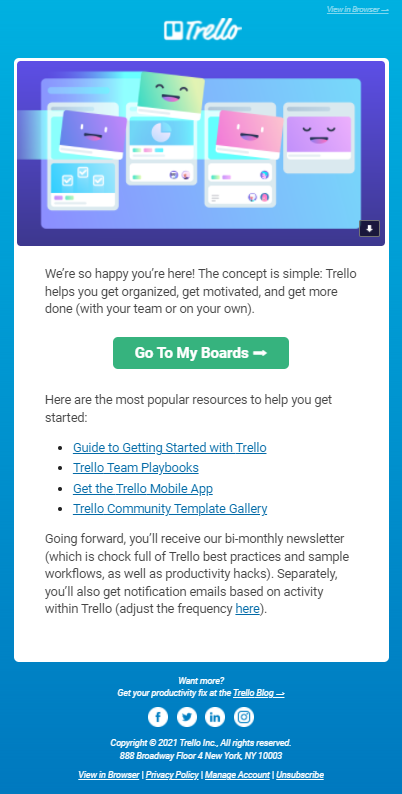
9 - Build a Better Abandoned Cart Series
Building a solid abandoned cart series is one of the essential eCommerce email marketing best practices.
According to Shopify – 88% of online shopping carts are abandoned before the customer completes a sale. Imagine if you could capture just a fraction of that 88% and encourage them to purchase? That’s the purpose of an abandoned cart campaign.
There are many different ways to build abandoned cart series, but a basic series usually consists of three emails. The first is sent within 30 to 60 minutes of the cart being abandoned. The second email goes out within 24 hours, and the third within 3 to 5 days. You can experiment and A/B test different timing or use automation to find the best time and frequency to deliver the next email.
A good abandoned cart series should bring back 10% to 15% of customers and the difference will come down to how well your series is optimized. Initially, a 5% improvement may not seem that significant, but realize going from 10% to 15% is a 50% improvement that will continue pay dividends over time.
If you're looking for a place to start, Shopify put together a great guide showing 16 amazing abandoned cart emails that might provide some inspiration.
10 - Offer Offers
Costumers look for the best bang for their buck and discounts are the next best thing.
Provide promotional offers for all subscribers. Offer and entice consumers if you have a sitewide discount, new product launch or seasonal incentives going on.
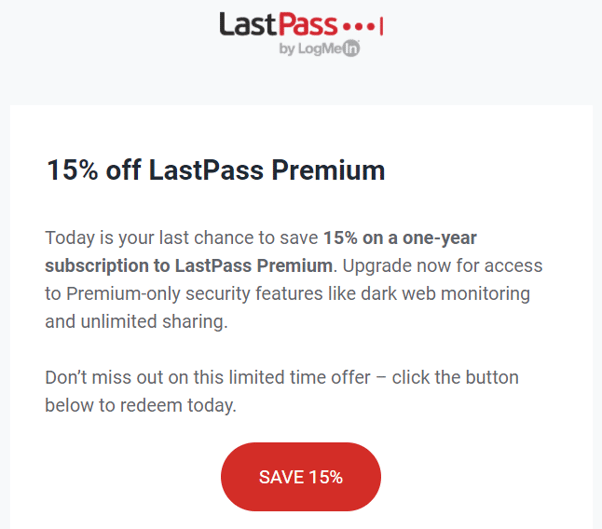
Offer exclusive deals for active customers/loyalty program. Take care of your VIP customers by offering VIP perks only available to your loyalty program. As it is, the probability of selling to an existing customer is 60-70%, while the probability of selling to a new prospect is 5-20%.
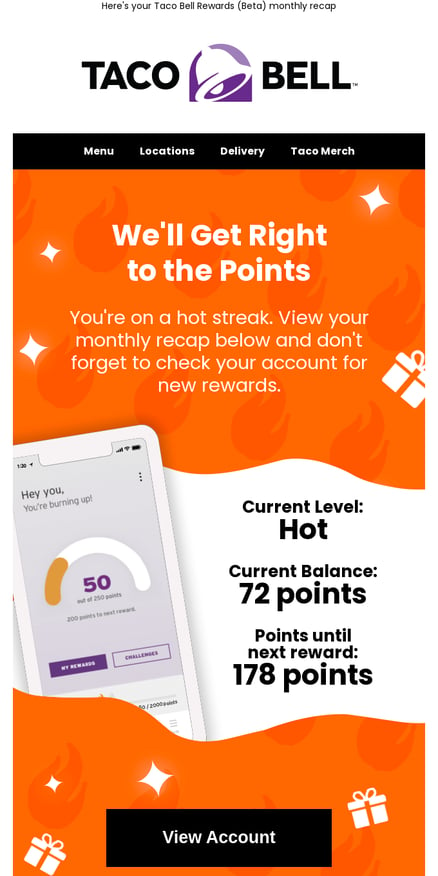
Source- Really Good Emails
Send wishlist and back-in-stock notification emails. Don’t forget to send updates about back-in-stock and wishlist items. Give shoppers a reason to return with a wishlist. Customers like to be notified about items they really want
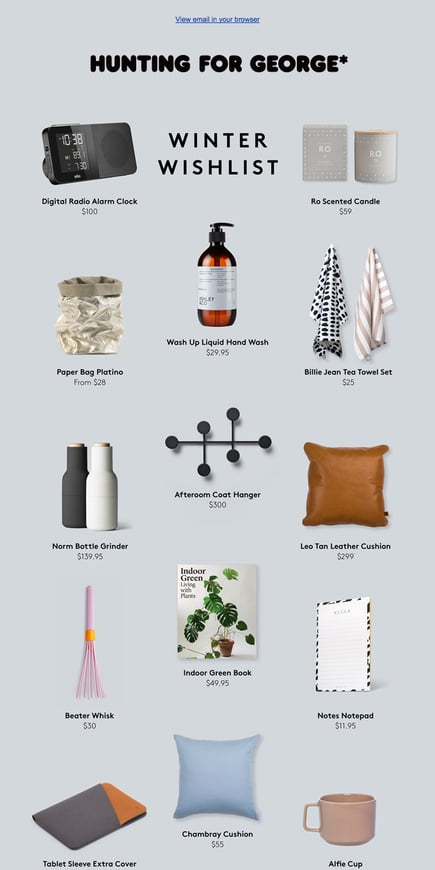
Source - Really Good Emails
Run a referral program. Turn customers into brand advocates using a referral system. Consider the fact that 92% of consumers trust recommendations from friends over advertisers, this is a powerful tactic to add in your eCommerce email marketing strategy.
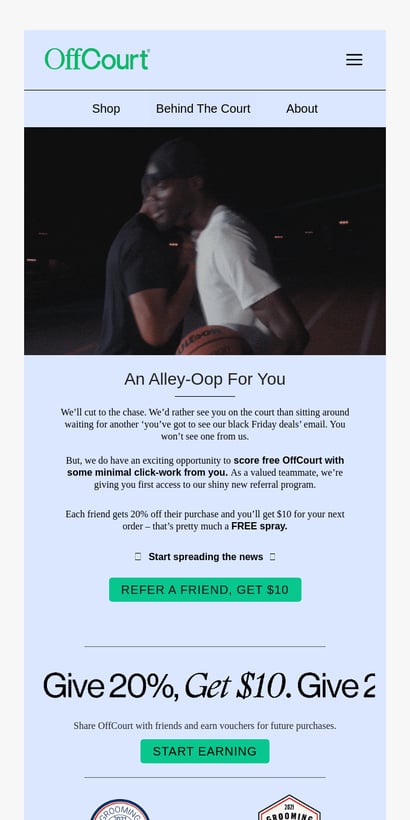
Source - Really Good Emails
11 - Encourage Customer Reviews
Social proof is paramount in today’s ecommerce. It shows and builds trust between the brand and the individual consumer. Data shows that 88% of consumers trust user reviews as much as personal recommendations.
Reach out to customers that recently purchased, better yet, automate the process. Encourage them to leave reviews not only about the product but the process and customer service.
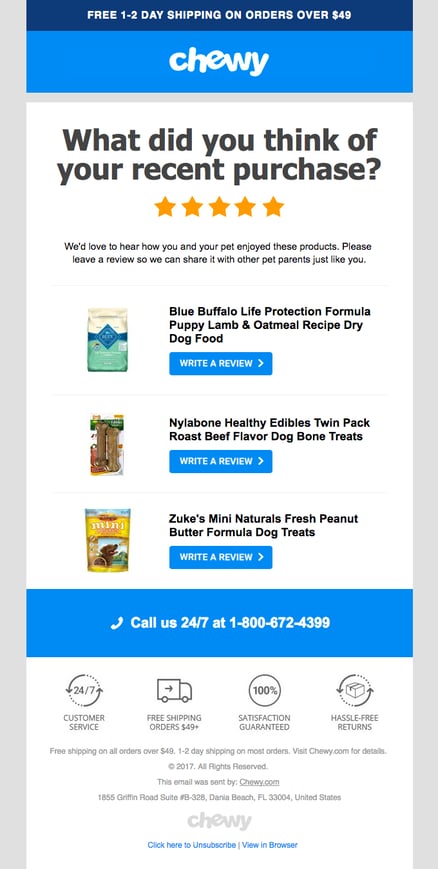
Source - Really Good Emails
12 - Review and Improve
In closing, probably the most important best practice in building a successful ecommerce email marketing program is to never stop reviewing and improving. Creating new content, trying new software and building new workflows is exciting, but often the easiest improvements come from tweaking your existing workflows and email templates. That series you thought was high-performing 6 months ago, may seem anemic now that you’ve seen how a better-optimized email workflow performs.
Set reminders on your team calendar to check in and review all aspects of your program. Trends change, software changes, audience demographics change and as your business grows, you'll continue to learn and change as well.
Now that you’ve learned the 12 ecommerce Email Marketing Best Practices, take the next step and learn advanced email marketing techniques in one of our other free guides.
